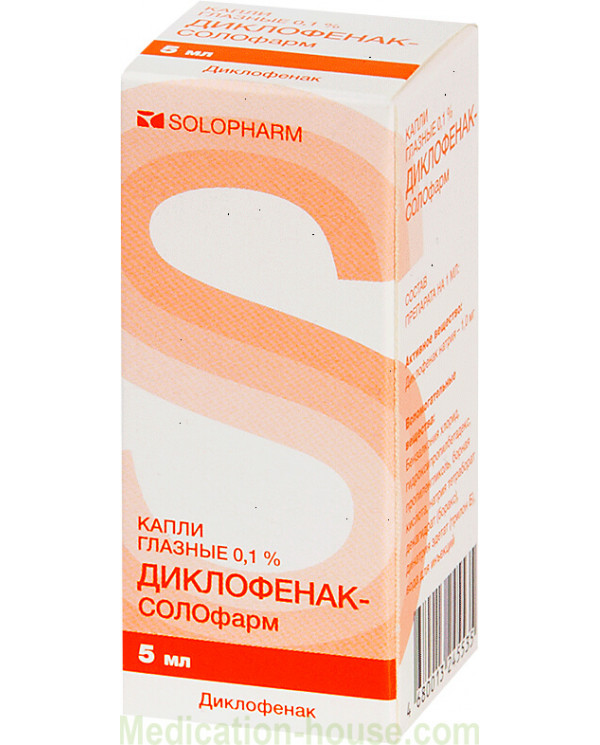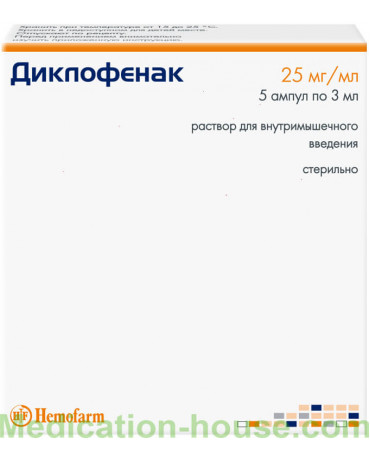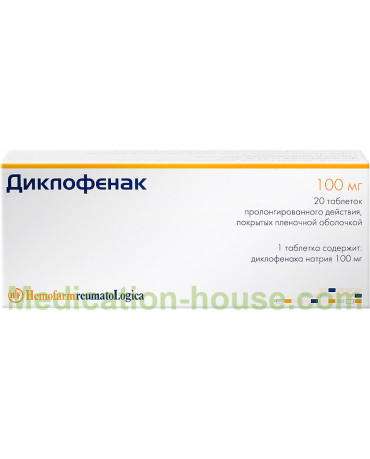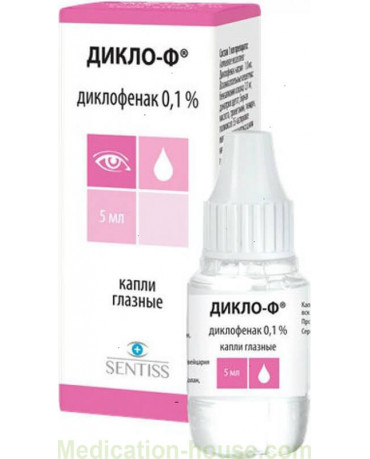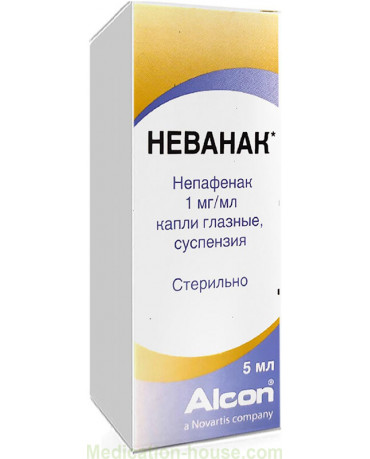Diclofenac eye drops instruction
You can buy Diclofenac eye drops on this page
Composition and form of release
Diclofenac eye drops are transparent or slightly yellowish in color. Drops have no inclusions, suspensions, flakes. The effect of the drug is due to the main component - sodium diclofenac. The structure additionally includes:
polyethoxylated castor oil (macrogol glyceryl ricinoleate);
trometamol;
mannitol;
purified water;
disodium edetate dihydrate;
1M solution (hydrochloric acid);
benzalkonium chloride.
The drug in the form of sterile drops is packaged in glass darkened dropper bottles with a volume of 5 ml. The carton contains 1 bottle with drops and instructions - insert.
Pharmachologic effect
The drug has an analgesic and anti-inflammatory effect, which is due to the main active ingredient. It inhibits cyclooxygenase, as a result of which the reactions of the arachidonic cascade are blocked. Also, diclofenac sodium disrupts the release of lysosomal enzymes and the synthesis of:
leukotrienes;
prostaglandin E2;
thromboxane A2;
F2 alpha prostaglandins;
prostacyclin.
In inflammatory processes after surgical treatment on the organs of vision, the drug reduces the severity of pain, edema.
After instillation, the maximum concentration of the drug in the anterior chamber of the eye is observed after thirty minutes. When applied topically, the product penetrates into the aqueous humor of the eye. When instilled into the eyes, the components of the drops are not absorbed and practically do not enter the systemic circulation, that is, the drug has no effect on internal organs and systems.
Indications for use
According to the instructions, the drug is prescribed for:
increased photosensitivity;
tearing;
corneal burns;
eyeball injuries;
inflammatory and infectious processes in the anterior parts of the eye;
corneal erosion;
inflammation after trauma and wounds of the eyeball (penetrating and non-penetrating).
Also, drops are used to relieve pain after laser correction, after surgical treatment for diseases of the organs of vision (including after removing the lens).
Contraindications
Diclofenac eye drops, like other drugs, has a number of restrictions for use:
intolerance to at least one substance that is part of the drug;
bronchial asthma (including aspirin asthma);
age up to two years;
hypersensitivity to NSAIDs (non-steroidal anti-inflammatory drugs);
third trimester of pregnancy.
Drops are used with caution in epithelial herpetic keratitis, diseases associated with bleeding disorders (increased bleeding, hemophilia, etc.), in elderly people and children. Particular caution is required in the presence of gastric and duodenal ulcers, in women during the period of breastfeeding, and in the 1st, 2nd trimester of pregnancy.
Instructions for use
Before use, be sure to wash your hands with soap and water, to exclude the ingress of pathogenic flora on the dropper bottle. Before instillation, you must lie down and tilt your head back, slightly pull the lower eyelid with your index finger and drip the drops into the lower conjunctival sac. During instillation, do not touch the tip of the tube with the drug to the eyelashes, eyelids, skin, and also touch it with your hands.
To exclude irritation of the mucous membrane and discomfort, the bottle with drops must be warmed up in the palms to room temperature (the drug cannot be placed on heating devices). Shake the bottle immediately before instillation.
After instillation, you must close your eyes and move your eyes to the left, right or blink quickly to evenly distribute the drops over the surface of the eyeball. To reduce the likelihood of developing a systemic effect (that is, so that the drug gets into the blood as little as possible) and to increase its effectiveness (so that it lingers on the surface of the eye as much as possible), you need to close your eyes and lightly press the inner corner of the eye for 1 - 2 minutes.
Dosage for adults
Eye drops Diclofenac are used only for instillation into the eyes. If Diclofenac is used before surgery on the organs of vision, then 1 drop is instilled into the conjunctival sac, every 25 minutes, for 3 hours (that is, 5-6 times in 3 hours). After surgical treatment, 1 drop 3 times on the first day, then also 1 drop, but up to 5 times a day, the duration of treatment is prescribed individually, depending on the operation.
For diseases of the organs of vision, 1 drop in the sore eye up to 4 - 5 times a day. The duration of treatment should be determined only by a doctor, depending on the disease and its severity. The course of treatment should not exceed 28 days.
Use in pregnant and lactating women
According to the instructions, the use of the drug in pregnant women in the 3rd trimester is prohibited, since it can reduce the severity of training contractions before childbirth. For another period, it is used with extreme caution and only under the supervision of a doctor. The use of drops during pregnancy will be justified only if the potential benefit to the mother outweighs the possible risk to the fetus.
During breastfeeding, the drug is used with extreme caution. If its use is necessary, and it is impossible to replace Diclofenac drops with similar ones for certain reasons, then feeding is stopped for the period of treatment and resumed after it ends. To maintain lactation for this period, it is necessary to express breast milk and transfer the baby to artificial feeding.
Application in children
If the child is under 2 years old, then it is strictly forbidden to use drops. In children older than this age, the drug is allowed, but only a doctor can determine the dosage, frequency and duration of its use. It is forbidden to drip it on your own to the child, so there is a list of side effects. For babies up to 2 years old there is a huge number of similar drugs marked "for children".
Interaction with other drugs
The tool can be used in complex treatment with eye drops containing glucocorticosteroids. If there are indications, then Diclofenac drops can be simultaneously combined with other drugs for the treatment of diseases of the organs of vision (drops, ointments), the interval between instillations should be at least 10 minutes so that the next drug does not wash out the previous one.
The parallel use of Diclofenac with indirect anticoagulants, Digoxin, lithium preparations leads to an increase in their action. It is not recommended to use the medication with Diflunisal, because of the risk of bleeding from the gastrointestinal tract, as well as with other NSAIDs, Methotrexate, sulfonylurea agents.
Side effects, overdose
They rarely develop, and more often manifest themselves as local reactions in the form of:
itchy eyes;
redness of the conjunctiva;
fuzzy visual perception (manifests itself immediately after instillation;
irita;
corneal opacities (thorns).
On the part of the digestive system, nausea, vomiting are possible. Side effects in the form of an allergic reaction are manifested:
burning and itching in the eyes;
chills;
fever;
hyperemia of the conjunctiva;
skin rash (mostly erythematous);
hives;
angioedema of the face;
photosensitivity.
If one of the side effects occurs, you must stop using the drug and consult your doctor.
When using the medication, according to the instructions, the risk of overdose is practically zero. In case of accidental use of the drug inside, overdose symptoms are also unlikely, since the drops act locally.
Special instructions
Immediately after using the drops, blurred vision may appear, which is not always a side effect. Therefore, in this case, a person is not recommended to drive vehicles, mechanisms, and perform work at a height. You can start work or get behind the wheel 15 to 20 minutes after instillation.
During the period of treatment, do not wear soft contact lenses. If a person uses solid lenses, then they are removed before instillation in 5 minutes and put on again 20-25 minutes after the procedure. For the period of treatment, it is advisable to completely refuse to wear contact lenses, since they additionally irritate the mucous membrane, and their constant removal and putting on during instillation increases the risk of introducing pathogenic flora.
If you use NSAIDs for more than a specified period with an excess of the dosage, then in people susceptible to them, thinning, infiltration and perforation of the cornea are possible. Long-term drug treatment can change intraocular pressure, therefore, in this case, preventive examinations by an ophthalmologist are necessary.
Storage conditions, shelf life.
The shelf life of the drug is 3 years from the date of manufacture indicated on the package, after its expiration, the drug cannot be used. After opening the bottle, the drops retain their healing effect for up to 1 month. Store the drug in a place protected from sunlight, children, at a temperature of 15 - 25 C. Drops should not be frozen.
Reviews
Alexander, 32 years old
A year ago at work I got an eye injury, while sawing a tree, chips got into my eyes. He did not ask for time off from work and simply washed his eyes with water. In the evening, one eye turned slightly red and hurt a little. In the morning I barely opened it, the pain was terrible, and the eye reddened even more. I went to a doctor, he prescribed Diclofenac. I buried them 4 times a day, one drop. On the 2nd day it became a little easier, on the 5th day all the symptoms disappeared.
Valentina, 23 years old
My dad had an eye operation, and a day before it, as well as after it, he was prescribed Diclofenac drops. As the doctor explained, they were needed to reduce the risk of inflammatory complications and to relieve pain after surgery. Then I also used them when the eye became very inflamed after swimming in the river, and they helped very quickly.
Dmitry, 34 years old
My son was prescribed eye drops Diclofenac when he was 9 years old. At school, sand got into my eyes, I came home with a reddened eye. His wife washed his eyes with chamomile and dripped Albucid, nothing changed in the morning, and the eye began to hurt. We continued to drip Albucid, but on the 3rd day the eye became inflamed. The doctor said that the child had purulent conjunctivitis, and prescribed Diclofenac drops. It was very cheap, and we doubted it would help. But it turned out to be very effective, the signs of inflammation disappeared after 3 days.
Christina, 29 years old
I was prescribed Diclofenac eye drops when I underwent laser vision correction. I dripped them a day before treatment, and then another 4 days after the operation. I did not have any complications after the correction, and neither did I have pain. Therefore, I am completely satisfied with the drug.
Terms of sell
You don't need a prescription from a doctor to buy Diclofenac eye drops.

